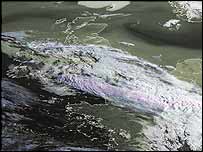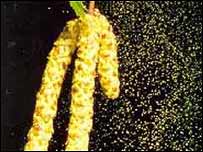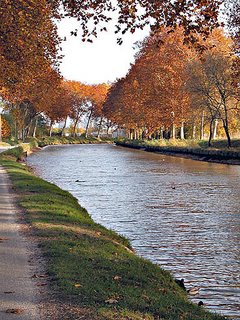
Last week, a friend of mine suffered the worst asthma attack she has had in years. Everyone is complaining about allergies -- people who have never had a problem, are rubbing eyes, complaining of unbearable itches, nursing sore throats, grabbing for the kleenex at every turn. And cars, furniture indoors and out, window panes --- every surface everywhere is covered in the finest of fine layers of yellow powder. Even the pool looks as if there is a thin layer of pale yellow oil covering the entire surface.
Apparently, weather experts at Met offices have been inundated with calls from baffled people all over Europe and Britain. And the answer? It appears that the phenomenon is caused by birch pollen that is being blown across the North Sea from Scandinavia. Satellite images taken over the last two weeks show a large yellow-green plume sweeping up the coast.

A Met Office spokesman said a wet April followed by a warm, sunny early May had produced record levels of birch pollen in Denmark.
"The explosion of birch pollen in Denmark this year has been caused by near-perfect weather conditions over the last few weeks," he said. "A late start to the pollen season, a wet April followed by a warm, sunny early May have combined to see birch catkins releasing an enormous amount of pollen grains over just a few days."
There had also been widespread arable burning in the fields of western Russia which could have blown across Europe and contributed to the dust.
Recently, as I imagine in Spring every year, there was much written in the local press about allergies and the cause of allergies. Pollen and allergy experts abound these days -- and the consensus seemed to be that the Cyprus and the Birch trees are the most culpible in causing allergies. All local council botanists and gardeners have been asked not to plant these trees in public gardens and spaces, and even nurseries are encouraged to take these plants off their catalogue lists.
I get the impression that trees will have to stand firmly rooted if they are going to survive. Particularly in France, with its beautiful tree-lined avenues, some of which have been there for hundreds of years. Most of the older canals as well, such as the Canal du Midi, where the trees date back to the 1600's and today still form leafy cool green tunnels where a barge may float serenely for hours without ever being exposed to the harsh southern sun. Many of the main routes in France are similarly tree-lined thanks to Napoleon who wished to provide some shelter to his soldiers on their long marches across Europe to go fight in campaigns.

But -- as beautiful and attractive and comfortable these tree-lined avenues are for the traveller and the beholder, so they are a menace to the small-minded little bureaucrats who sit in their dingy little offices. And whenever they can get away with it, over the last thirty years, they have felled thousands of maples, planes and poplars because of fears that they distract drivers and cause accidents!
"Personally I have no hesitation in saying we can cut them down and plant elsewhere" says Jean Glavany, Agriculture Minister. I have no hesitation in saying let us cut M. Galvany down and deport him elsewhere -- such as to the Sahara dessert.............
But the policy may be about to change. A government crackdown on drink-driving and speeding cut the carnage on French roads by almost 20% last year, leading campaigners to argue that booze rather than bark is the real problem.
"People are at last realising that the trees are not what cause these deaths," said Chantal Fauché, of Arbres et Routes, (Association for the Protection of Road-side Trees (APRT)), a tree-protection group in the southern Gers region, where some of the worst felling has happened.
"It's drinking and speeding that are the real problems. If you tackle them, the deaths drop."
About 750 people a year are killed on tree-lined rural roads. The writer Albert Camus died in 1960 when he drove into a tree.
In 2001 a study suggested that road deaths in France would be halved if fixed objects were removed from roadsides. Barely 400,000 so-called arbres d'alignement are left today, compared with 3m a century ago.
But Ms Fauché argues the decades of felling did nothing to reduce road deaths.
The recent government regulations - reducing speed limits, tightening speed and breathalyser checks and increasing penalties - have had an almost instant effect.

(I was stopped on Saturday night at 40 minutes past midnight, just outside Lalinde -- the second time in so many months! -- and breathalysed. The monitor showed 00.000 -- the police loved it -- so did I! Does not happen too often!)
Ms Fauché has always argued that trees can help drivers to gauge their speed. She has faced death threats in the past and aggression from local communities. But now that drivers are slowing down and avoiding alcohol, her campaign is beginning to win support.
Ms Fauché founded her group when she noticed trees were disappearing in 1996. Five years later she convinced regional authorities not to chop down 120 trees. In Gers, where roads are lined with stumps, they have promised to replant 10,000 trees over the next 10 years, set further back from the road for safety.

Click on Link:
Chateau Lalinde : The perfect venue for your event
TAGS: Events Rent a chateau France
Chateau
Perigord Food Holidays in France Recipes







